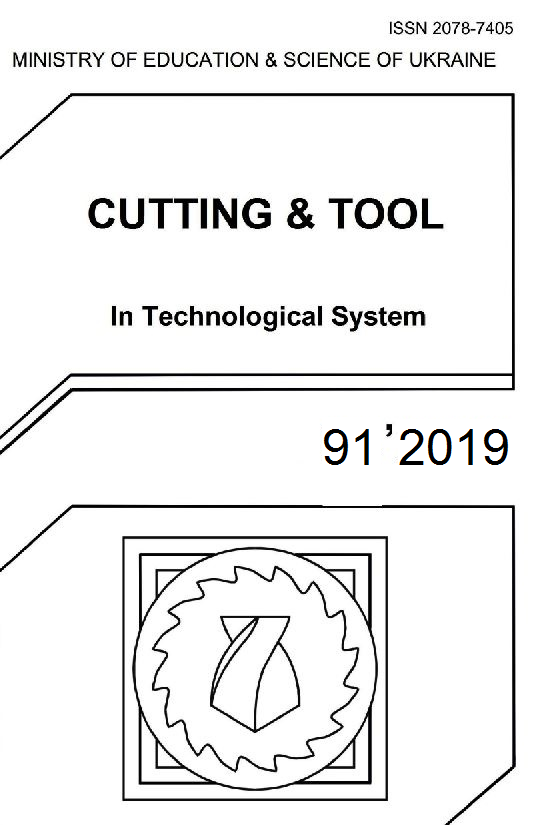STUDY ON THE APPLICABILITY OF COUPLED EULERIAN-LAGRANGIAN FORMULATION IN ABRASIVE WATERJET MACHINING SIMULATIONS
DOI:
https://doi.org/10.20998/2078-7405.2019.91.04Keywords:
Abrasive Waterjet Machining, Finite Element Method, Coupled Eulerian-Lagrangian Formulation.Abstract
Non-conventional machining processes are considered as reliable alternatives to the established conventional ones in the case of processing of difficult-to-cut materials. Especially, Abrasive Waterjet Machining (AWJM) is advantageous for this purpose, as it can handle a wide range of workpiece materials and does not cause heat affected zones. In order to study the phenomena occurring during AWJM, numerical simulations should be carried out along with experiments. As machining processes involve significant material deformation, Coupled Eulerian-Lagrangian (CEL) Finite Elements (FE) models have been proven significantly accurate for this purpose, compared to pure Lagrangian models. Thus, in the present study it is attempted to compare the predicted results of CEL and pure Lagrangian models in the case of AWJM and determine whether this method is applicable for the process or not. Simulation cases based on experimental results are employed and discussion on the predicted cutting zone dimensions, stress and temperature field is conducted.References
Kun-Bodnár, K., Kundrák, J.: Applicability of Waterjet Cutting for Different Machining Operations, Cutting & Tools in Technological Systems 79, pp. 102-107. (2011).
Kun-Bodnár, K., Kundrák, J., Maros, Z.: Machining of rotationally symmetric parts with abrasive waterjet, IOP Conference Series: Materials Science and Engineering 448, 012053. (2018).
Kun-Bodnár, K., Maros, Z.: Theoretical Determination of Removed Layer Depth at Abrasive Waterjet Turning, Cutting & Tools in Technological Systems 90, pp. 19-25. (2019).
Finnie, I.: Erosion of Surfaces by Solid Particles, Wear 3, pp. 87-103. (1960).
Zeng,J., Kim,T.: An erosion model of polycrystalline ceramics in abrasive waterjet cutting, Wear 193, pp. 207-217. (1996).
Hassan, A.I., Kosmol, J.: Finite element modeling of Abrasive Water Jet Machining (AWJM), Proc. 15th International Conference on Jetting Technology, Ronnby, Sweden, pp. 321-333. (2000).
Gudimetla, P., Yarlagadda, P.K.D.V.: Finite element analysis of the interaction between an AWJ particle and a polycrystalline alumina ceramic, Journal of Achievements in Materials and Manufacturing Engineering 23(1), pp. 7-14. (2007).
Kumar, N., Shukla, M.: Finite element analysis of multi-particle impact on erosion in abrasive water jet machining of titanium alloy, Journal of Computational and Applied Mathematics 236(18), pp. 4600-4610. (2012).
Shahverdi, H., Zohoor, M., Mousavi, S.M.: Numerical simulation of abrasive water jet cutting process using the SPH and ALE methods, International Journal of Advanced Design and Manufacturing Technology 5(1), pp. 43-50. (2011).
Wenjun, G., Jianming, W., Na, G.: Numerical simulation of abrasive water jet machining based on ALE algorithm, International Journal of Advanced Manufacturing Technology 53(1-4), pp. 247-253 (2011).
Jianming, W., Na, G., Wenjun, G.: Abrasive waterjet machining simulation by SPH method, International Journal of Advanced Manufacturing Technology 50 (1-4), pp. 227-234. (2010).
Feng, Y., Jianming, W., Feihong, L.: Numerical simulation of single particle acceleration process by SPH coupled FEM for abrasive waterjet cutting, International Journal of Advanced Manufacturing Technology 59 (1-4), pp. 193-200. (2012).
Ducobu,F., Rivière-Lophèvre, E., Filippi, E.: Numerical contribution to the comprehension of saw-toothed Ti6Al4V chip formation in orthogonal cutting, International Journal of Mechanical Sciences 81, pp. 77-87. (2014).
Ducobu, F., Rivière-Lophèvre, E., Filippi, E.: On the importance of the choice of the parameters of the Johnson-Cook constitutive model and their importance on the results of a Ti6Al4V orthogonal cutting model, International Journal of Mechanical Sciences 122, pp. 143-155. (2017).
Ayed, Y., Robert, C., Germain, G., Ammar, A.: Development of a numerical model for the understanding of the chip formation in high-pressure water-jet assisted machining, Finite Elements in Analysis and Design 108, pp. 1-8. (2015).
Hassan, A.I., Chen, C., Kovacevic, R.: On-line monitoring of depth of cut in AWJ cutting, International Journal of Machine Tools and Manufacture 44 (6), pp. 595-605. (2004).
Johnson, G.R., Cook, W.H.: A constitutive model and data for metals subjectd to large strains, high strain rates and high temperatures, Proc. the 7th International Symposium on Ballistics (1983).
Buchely, M.F., Wang, X., Van Aken, D.C., O'Malley, R.J., Lekakh, S., Chandrashekhara, K.: The Use of Genetic Algorithms to Calibrate Johnson-Cook Strength and Failure Parameters of AISI/SAE 1018 Steel, Journal of Engineering Mater. Technol 141(2), 021012. (2018).
Simulia, D.: Abaqus 6.17 Documentation, Provid. RI, USA DS SIMULIA Corp., 2017.
Anwar, S., Axinte, D.A., Becker, A.A.: Finite element modeling of abrasive waterjet milled footprints, Journal of Materials Processing Technology 213 (2), pp. 180-193. (2013).
Momber, A.W., Kovacevic, R.: Principles of Abrasive Water Jet Machining, Springer-Verlag London (1998).
Downloads
Published
Issue
Section
License
Copyright Notice
Authors who publish with this Collection agree to the following terms:
1. Authors retain copyright and grant the Collection right of first publication with the work simultaneously licensed under a Creative Commons Attribution License that allows others to share the work with an acknowledgement of the work's authorship and initial publication in this Collection.
2. Authors are able to enter into separate, additional contractual arrangements for the non-exclusive distribution of the Collection's published version of the work (e.g., post it to an institutional repository or publish it in a book), with an acknowledgement of its initial publication in this Collection.
3. Authors are permitted and encouraged to post their work online (e.g., in institutional repositories or on their website) prior to and during the submission process, as it can lead to productive exchanges, as well as earlier and greater citation of published work.

